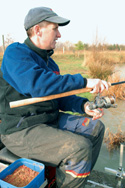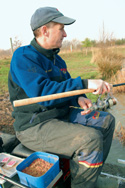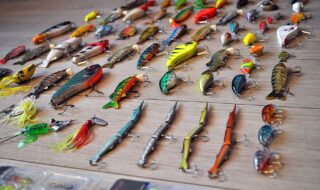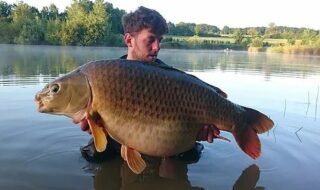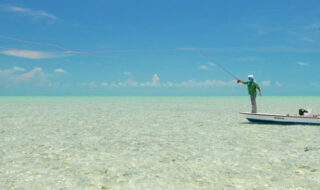Blockend feeders are a valuable addition to any match anglers tackle box, but there’s no point carting them around in your box if you don’t know how to get the best out of them. Fox backed Mark Pollard tells you everything you need to know about fishing this method.
COLD water fishing is all about having confidence in what you’re doing and the blockend feeder is one of many successful methods of targeting carp.
Many anglers prefer a straight lead approach when the temperatures plummet, but now the water’s starting to warm up slightly, re-thinking your attack should improve your catch rate – the blockend feeder is definitely worth a look. I helped Fox Match launch some flighted feeders and here’s how they are best used.
The Right Time
Knowing when a blockend feeder will be most effective is one of the key factors in its success. Many commercial waters are now beginning to warm up as the spring season approaches and many respond well to a straight lead approach when the water’s really chilled, but this is only a method that works when the fish are already in your peg. The blockend feeder is different because you’re feeding the swim to encourage fish that are already there to feed and you’re also drawing other fish into the peg at the same time. I know other venues where you have to fish single hook baits, but I don’t think this is right and I honestly believe that even on the coldest days, you need to keep some feed going through the peg.
Where To Fish?
When you draw a peg and are confronted by a large expanse of water, deciding where to cast your feeder is possibly THE most important factor that will determine whether you catch or not. Today I’ve got an island in front of me at around 45 yards and this makes
 |
| The Fox flighted feeders |
an obvious area to target, even when the waters at its coldest. The fact is simple – carp love islands. It’s very unlikely they’ll be tight up against the island because of the shallow water and the fishes metabolism is not high enough for them to want to move out of their comfort zone to feed elsewhere.
In these conditions I will start around 25 metres off the bank where I know there is reasonable depth. Knowing the venue helps massively because you’ll know of any deeper areas or places where the fish shoal up in the cold. Later on in the session I intend to cast tighter to the island and I’ve found this usually brings you an extra fish or two.
If you don’t have an island then it’s best to get some local information, as this will usually give you a starting point. If there’s a deep channel for example, this makes an obvious area to cast to, it’s all about doing your homework.
Feeding
Feeding the right amount of maggots is very important to success. Many anglers simply fill the feeder to the limit and cast out into the lake. This is not the way to go about feeding the swim correctly because you are allowing the feeder to determine how much you feed rather than taking into account the water temperature, possible target weight and weather conditions.
Today I’m using the Fox Match Flighted feeders and I’ve chosen the small 1/2oz design as it gives me enough weight to cast accurately, while being small enough to prevent me from overfeeding the peg, but I’ll talk more in detail about the feeders in a minute.
I’ve brought around two pints of maggots with me for the session, but I don’t expect to get through anywhere near that. My bait consists of half-a-pint of red maggots and one-and-a-half pints of white maggots and the reason for this is simple. I believe that carp prefer red maggots to white ones, so by giving them less red maggots in the feed, they search each one out and when I use one on the hook…bingo!
Hook baits are important and my favourite is a red and white combination simply because I’m covering all my options. Sometimes this is better or sometimes a single or double red is a better offering and you’ll find that by changing around throughout the session you’ll find the one they prefer. I’ve also brought some Van den Eynde corn with me as a change bait, which gives me another option. I will start the session by filling the feeder three-quarters full, but I’ll then vary the feed accordingly, whether this means cutting it right down or increasing it.
Preparing The Feed
Although I will only feed maggots today, I do like to make them a little bit different from every one else’s. All I do is to riddle off the maize the maggots are stored in and then add some Ringer’s Bag-Up Carp Mix to give them a fishmeal boost.
 |
| Mark adds fishmeal to his maggots to give them a boost. |
 |
| Take your hook bait from the same tub you are using to feed with. |
The dry particles explode out of the feeder once they’re on the bottom, which is a little tip I believe gives me the edge, especially when the fish are cagey and difficult to catch like they are today.
I also believe it’s important to take the hook bait maggots from the same tub you’re filling the feeder with to ensure all the baits are the same. The groundbait just puts a smell in the water and because it has not been wetted it adds no feed value, it’s simply an attractor.
The Feeder
The feeders I’m using today are a new design from Fox Match that I’ve had a hand in developing. They’re flighted feeders that cast much straighter than any other blockend feeder I’ve ever used, meaning I don’t need to use any extra weight to gain accuracy. I mentioned that I’ve chosen to use the medium-sized 1/2oz design, as that will give me enough weight to punch the feeder the distance I require. Another major plus of these feeders is that you don’t have to compensate for any wind, you just aim where you want it and it goes there – it’s almost cheating!
They come in two designs – the first features a standard swivel and Powergum attachment, while the others are an in-line design and feature hollow plastic tubing through the centre to give a different type of rig all together.
The fins definitely help with the flight and because the weight is central and at the ‘leading’ end of the feeder, they fly exceptionally well. They’re also green in colour, which helps them blend in once they’re on the deck.
Tackle Choice
I’ve chosen to use the Fox Vario Multi Feeder at 12ft today because I think that’s an ideal length to play and land fish on. A shorter rod hasn’t got the power to punch the feeder to the island, whereas a longer, 13ft model, makes netting fish more difficult and you lose a degree of control when they’re near your feet. The 12ft version is the ultimate choice.
This rod has a through action that allows the hooklength to be cushioned if a fish makes a sudden lunge. Today I’ve selected the No3 tip, which is 11/2oz, and is ideal for the conditions I’m facing. A lighter tip would mean I would constantly have a bend in it as the tow and wind would have too much of an effect, whereas a heavier version would not be sensitive enough and I’d not see all the indications. The correct tip enables me to build up a picture of what’s going on in the swim.
The reel I’ve chosen today is a Shimano Twin Power XTR1000, which is a rear ‘fighting drag’ model that I find perfect for this sort of feeder fishing. I like to use a robust line when I’m on the tip and for today’s session I have loaded the spool with 6lb Fox Soft Steel mainline which is both strong and supple.
The Rig
There are many different ways of attaching the feeder and hooklength to the mainline, but I’ve arrived at a rig that has caught me hundreds of carp and has not yet let me down. Many waters insist a ‘free-running’ set-up must be used to prevent tethered fish and this water’s no different. I prefer a free-running rig anyway, because although it’s safe, you seem to get better bites because there’s less resistance when a fish picks the hookbait up.
First of all, I will thread the feeder onto the mainline before tying a 2” loop into the end of the line. I will then attach a Drennan Swivel
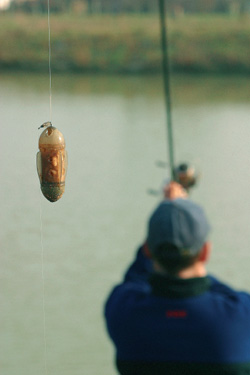 |
| Accuracy is crucial in colder weather |
Bead via the loop. This gives the feeder a free running set-up, while the knot created by the loop helps to pull the hook in as the feeder jams against the knot. I will start off on a 0.13mm diameter hooklength at this time of year and I like to start off with a length of 18 inches to two foot because the fish won’t be willing to move too far to pick up the bait. Dropping the hooklength lower than this diameter is dangerous, especially when you’re fishing for decent fish, and I don’t think it’s necessary anyway. The hooklength is attached in the same loop fashion to the other end of the swivel and the only hook I use for my carp work is the Fox Match Carp Feeder. Today I’ve chosen a size 18.
Nervous Twitch
I like to twitch the feeder regularly when I’m fishing the blockend for carp. The reason is simply because I’m using a two-foot-long tail and the maggots are escaping from the feeder two feet away from the hookbait. Twitching the feeder results in the hookbait ending up right in the middle of the feed and the carp doesn’t have to move off to find my hooker. Sometimes twitching the feeder can result in a bite, whereas leaving it in one spot can easily result in a biteless cast. This tip doesn’t always work, but it’s something else to try on a hard day.
Accuracy
Accuracy is another very important aspect of cold water carping and the angler who is consistently on the mark will always catch more than one who’s not. I will clip up at this time of year simply because the carp don’t run as hard as they do in warmer weather.
Don’t get me wrong, sometimes you’ll still have to unclip, but on the majority of occasions it isn’t necessary.
You want the carp to know where the feeder will land so they’re there and waiting for the next lot of feed and you can only achieve this by using the line clip. Providing I’m not fishing tight against the island I’ll try taking another three feet or so off the spool, so the tackle lands just beyond where I have been casting. This so often results in a response because wary winter fish can back off the feed area and you actually trick a fish into feeding.
Play It Right
Many anglers now play carp off the clutch, but I’ve never found this works for me so I’ll always play fish by backwinding when necessary. If a fish is heading for a snag, it’s very hard to stop the clutch spinning, but if you’re using the backwind you can tighten down and often stop the fish in its tracks.
Another very important point about playing fish is the way you hold the rod. Many rest the rod against their forearm and play the fish that way, but I like to hold the rod off my arm and just use my wrist as a pivot point.
This means that if a fish lunges the rod gives way and then you can react by back winding, but it’s often that split second when the fish runs that most are lost. This is the only way I ever play fish on the rod now and I urge you to try it if you don’t already play your fish this way.
|
|
Conclusion
 |
| Mark reckons he caught on a day when many would have struggled. |
I started off the session by filling the feeder three-quarters full and I had five quick casts to get some bait down on the bottom. I then started by fishing a red and a white maggot on the hook, while still feeding the swim with the same amount of bait. An early carp followed after around an hour and it then took an hour before the fish returned. I unclipped and took off three feet of line, clipped up again and cast out, which resulted in the rod flying round as soon as the feeder hit the water, and carp number two was safely in the net. It was just a case of being confident and waiting for the carp to return.
Carp three and four followed quickly, but I had to leave the feeder in the water for around 10 minutes before I had a response. It’s still very important to keep the feed going in, however, and regularly feeding 25 maggots helped to spur fish into feeding. I caught the last fish in exactly the same spot I’d caught three others, proving the worth of clipping up and being accurate. I tried casting to a couple of different spots throughout the session, just in case the fish had moved off, but these movements didn’t produce a response.
I really do believe that giving the maggots a boost by adding the groundbait has helped me to catch fish where I wouldn’t have normally – and without a doubt the feeders have helped my accuracy and have ultimately helped me to catch more.
Coldwater blockend feeder fishing is definitely a waiting game, but if you put my tips into practise you’re sure to put more carp in your net.
VENUE FILE
Venue name: Chestnut Pools Fishery
Location: Langford, Near Biggleswade
How to get there: Head along the A14 towards Huntingdon and join the A1 (South). Travel through Sandy until you reach the Biggleswade roundabout. Follow signs for Biggleswade and turn left past Sainsbury’s and over the bridge. Turn right at the traffic lights and you’ll see the fishery situated around a mile on the right hand side
Controlled by: Pete Wilson
Contact for club and open matches bookings: Pete on 01462 710865
Number of pegs: 30
Rules: Barbed hooks only, no hooks bigger than a size 10, two keepnets must be used in matches, carp pellets only (no trout pellets), all nets have to be dipped before use and free running rigs are a must


